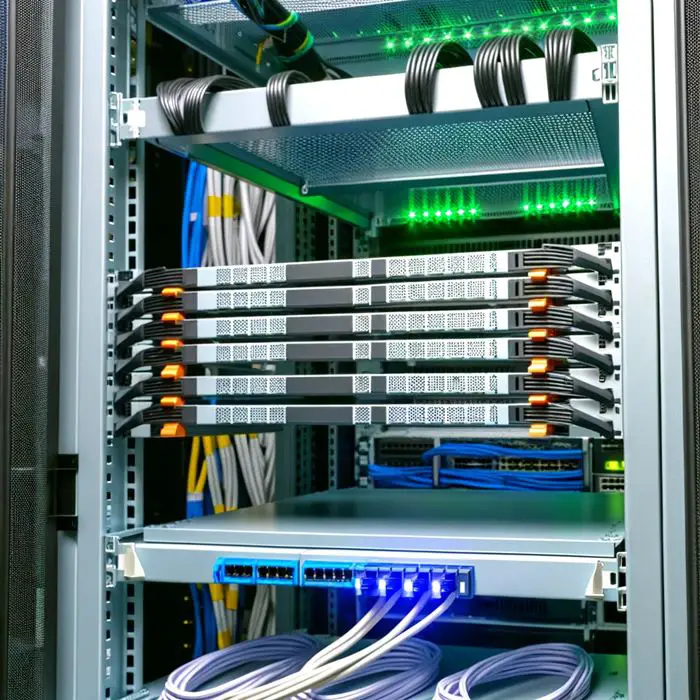Server furniture, including durable multi-level metal constructions like cabinets and racks, plays a pivotal role in setting up telecommunication infrastructures. These components are essential for storing network equipment and accessories efficiently, affecting the overall performance of IT systems. This guide focuses on the importance of server rack organization and outlines best practices for optimizing telecommunication infrastructures, highlighting the benefits of a well-organized IT environment.
Key Benefits of Efficient Server Rack Organization
1. Improved System Performance and Accessibility
An optimal server rack layout ensures that IT components do not communicate or exchange heat unnecessarily, leading to better system performance. Easy accessibility to all components not only reduces downtime but also accelerates repairs, directly influencing IT infrastructure efficiency.
2. Enhanced Cable Management
Effective cable wiring within server racks facilitates optimal space usage and simplifies maintenance processes. By developing the most effective routes, server rack space is optimized, contributing to the overall organization and efficiency of the IT infrastructure.
Read also: Understanding The Differences In Computer Cables
3. Optimal Airflow for Cooling
A well-thought-out hardware layout allows for unobstructed air circulation, which is crucial for maintaining appropriate cooling levels within the server rack. Improved airflow prevents overheating, ensuring that devices operate within optimal temperature ranges.
4. Efficient Use of Space
The strategic allocation of hardware not only improves the ergonomics of the workspace but also maximizes the use of available space. This section emphasizes the importance of effective space allocation in creating a functional and organized server rack setup.

5. Reducing Downtime Through Organization
The organization of server racks plays a significant role in minimizing downtime. With an optimal layout, staff can quickly perform preventative maintenance tasks and troubleshoot issues, thereby maximizing server rack efficiency and reducing operational interruptions.
Read also: The Different Types of Servers in Computer Networks, Explained
Strategies for Organizing Server Racks
1. Cable Management Techniques
Proper cable management is crucial for maintaining an organized server rack. Utilizing accessories like vertical and horizontal cable managers, patch panels, and cable ties can help achieve a neat and compact arrangement, improving visual clarity and simplifying maintenance tasks.
2. Effective Airflow Management
Maintaining optimal airflow within server racks is essential for preventing equipment overheating. Strategies such as the hot aisle/cold aisle configuration and the use of blanking panels help in creating an efficient cooling environment.

3. Strategic Equipment Placement
The placement of equipment within a server rack should be based on factors such as weight, frequency of access, and type. This section provides insights into organizing server racks effectively to ensure stability and accessibility.
Read also: How to Build a Virtualization Server
4. Utilizing Server Rack Accessories and Selecting the Right Cabinet
A variety of server rack accessories are available to aid in the organization and maintenance of IT equipment. Items such as anti-slip mats, rack shelves, and casters not only enhance the functionality of the server rack but also contribute to the overall safety and efficiency of the IT infrastructure. For those in need of a spacious solution for a growing IT environment, the 42U server rack cabinet offers ample space for thousands of active devices and accessories. Discover your perfect 42U cabinet with Sysracks’ trusted selection, designed for any purpose, by visiting https://sysracks.com/catalog/racks-by-size/42u/.

Read also: How to Choose a Server for Your Business
Frequently Asked Questions (FAQs)
1) What is the best way to arrange a server rack?
Strategically place heavier equipment at the bottom and ensure proper cable management for airflow and accessibility.
2) Where is the best place for a server in a rack?
Place servers in the middle or lower positions for optimal weight distribution and airflow management.
3) How much space should be between server racks?
In general, allow at least 4 inches of space between server racks for airflow and maintenance access. For larger data center environments, follow industry guidelines, which recommend a minimum clearance of 121.9 cm (48 inches) from the back of one rack to another to ensure optimal airflow and accessibility.
Conclusion: Enhancing IT Infrastructure Through Effective Server Rack Organization
The organization of server racks is a critical aspect of IT infrastructure management, directly impacting system performance, efficiency, and scalability. By implementing the best practices outlined in this guide, including the selection of appropriate cabinets from trusted suppliers like Sysracks, IT professionals can design highly functional infrastructures that meet both current and future technological demands. Remember, a well-organized server rack is the backbone of a reliable, efficient, and scalable IT environment.


